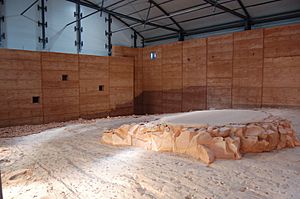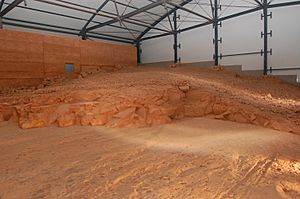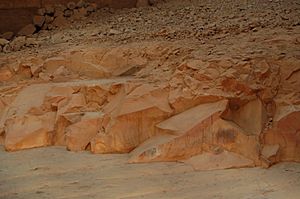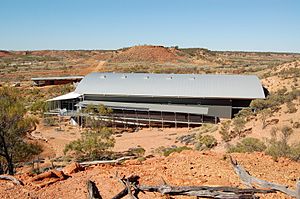Lark Quarry Dinosaur Trackways facts for kids
The Dinosaur Stampede National Monument at Lark Quarry Conservation Park is a very special place in Queensland, Australia. It's often called just Lark Quarry or Dinosaur Stampede. This site is famous for having many fossilised dinosaur footprints.
For a long time, people thought these footprints showed a big dinosaur chasing about 150 smaller, two-legged dinosaurs, causing them to stampede. However, new studies suggest it might have been a natural river crossing instead.
These amazing fossils are between 104 and 92 million years old. They are found in sandstone from the Winton Formation. Since April 2016, the Australian Age of Dinosaurs Museum helps manage the tours here. This helps visitors learn more about Australia's unique dinosaurs and their ancient world. In 2018, over 14,000 people visited the site.
Lark Quarry is located about 110 kilometers (68 miles) southwest of the town of Winton in western Queensland.
Contents
How the Tracks Were Made
For many years, the main idea was that about 104 to 92 million years ago, a group of small dinosaurs was drinking water. These included chicken-sized dinosaurs called coelurosaurs and larger ones, like emu-sized ornithopods. Suddenly, a much bigger meat-eating dinosaur, possibly an Australovenator, appeared. This large dinosaur could have been up to 6 meters (20 feet) long. Its arrival was thought to have scared the smaller dinosaurs, making them run away in a panic.
The tracks of the small coelurosaurs are called Skartopus. The tracks of the ornithopods are called Wintonopus. The large tracks were first thought to be from a big meat-eating dinosaur. People believed the smaller dinosaurs stampeded past the large dinosaur, leaving thousands of footprints in the wet mud near a lake.
New Ideas About the Tracks
However, in 1994, scientists began to think differently. They realized the large tracks were made by a big plant-eating dinosaur, not a meat-eater. This plant-eater might have been similar to Muttaburrasaurus. These large tracks are now thought to belong to the ichnogenus Amblydactylus.
More recent research by Dr. Anthony Romilio and his team from The University of Queensland has added even more to this new idea. They studied the rocks and found that the area was likely a seasonal river. Water levels changed often, and the river flowed at different speeds. This means the footprints were probably made over a period of time, maybe several days, as dinosaurs crossed the river channel.
Dr. Romilio's team also found that the shapes of the Skartopus and Wintonopus footprints were very similar. They even found both types of prints in the same dinosaur's path! This suggests that both Skartopus and Wintonopus tracks were made by the same type of plant-eating, two-legged dinosaur.
How the Tracks Were Saved
No matter what exactly happened, soon after the footprints were made, the water level rose. This covered the tracks with sand before the mud could dry out. As water levels kept changing, more layers of sand and mud covered the footprints. Over millions of years, this area, which was once a rich river plain with sandy channels, swamps, and forests, dried up. The sediment covering the footprints was pressed down and turned into hard rock, preserving the tracks perfectly.
Discovery and Protection
The dinosaur footprints were first found in the 1960s by a local station manager named Glen Seymour.
Later, in 1976 and 1977, paleontologists from the Queensland Museum, including Mary Wade and Tony Thulborn, along with scientists from the University of Queensland, began digging at Lark Quarry. The quarry was named after Malcolm Lark, a volunteer who helped remove a lot of rock. They removed over 60 tonnes (about 66 tons) of rock and uncovered about 200 square meters (2,150 square feet) of the fossil layer. This amazing area shows about 3,300 dinosaur footprints!
At first, a simple roof was built to protect the site, but it wasn't enough to stop damage from the weather. So, in 2002, a special building called the Conservation Building was constructed. This building now protects the main collection of footprints. It helps keep the temperature and humidity steady, stops water from running over the tracks, and keeps people and animals from stepping on them.
Because of its unique importance for research and its rarity, the Dinosaur Stampede National Monument was added to the Australian National Heritage List on July 20, 2004.
Lark Quarry and Movies
Some people have said that the Lark Quarry tracks inspired the famous Gallimimus stampede scene in the movie Jurassic Park. This was because the tracks were first thought to show a dinosaur stampede caused by a predator. However, the idea of a stampede has been questioned, and a consultant for Jurassic Park has said that the tracks did not inspire the movie scene.
New Research in 2025
In 2025, Dr. Anthony Romilio used Lark Quarry to show how digital methods can help study dinosaur track sites. He made the first accurate measurements of the exposed track surface, which is 210 square meters (2,260 square feet). He also counted the actual number of footprints on that surface: at least 3,436 footprints! These numbers don't even include the many pieces of rock with tracks that have been moved to museums elsewhere. Dr. Romilio's research showed that Lark Quarry has an incredibly high density of footprints, with 16.36 footprints per square meter. While this is very high, it's not the highest in Australia. For example, some dinosaur footprints from the Early Jurassic period have over 70 footprints per square meter!
See also
- List of fossil sites
- Protected areas of Queensland







